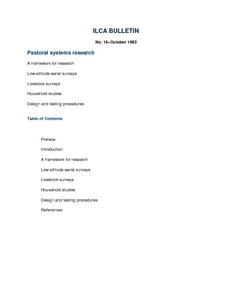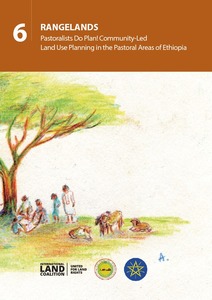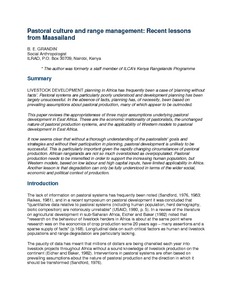Pastoral systems research
Selection of presentations made at the workshop on "Pastoral systems research in sub-Saharan Africa", describing the framework used by ILCA for pastoral systems research (PSR), examining methods used in the descriptive and diagnostic stage of PSR, and showing how the design and testing procedures are followed in practice; with particular reference to low-altitude aerial surveys, livestock surveys & household studies.
Pastoralists do plan! Community-led land use planning in the pastoral areas of Ethiopia
This paper consolidates a set of case studies which document how pastoralists plan land and resource use in pastoral and agro-pastoral areas of Ethiopia. These case studies are drawn from the regional states of Afar, Somali, Southern Nations, Nationalities, and Peoples (SNNP), Oromia, and Gambella. They describe not only why, how, and when pastoralists plan, but also the management and governance structures that control planning processes and the later implementation of the plans.
Pastoral culture and range management: Recent lessons from Maasailand
Reviews the appropriateness of three major assumptions underlying pastoral development in East Africa, viz, economic irrationality of pastoralists, the unchanged nature of pastoral production systems, and the applicability of western models to pastoral development.
Pastoralism in Kenya and Tanzania: Challenges and opportunities in animal health and food security
Pastoralism is used to describe a society that derives majority of their food and income from livestock. This form of farming system is largely practised in the arid and semi-arid lands (ASAL). It is estimated that 70% of the landmass in the Horn of Africa is dry land; in Kenya 80% of the landmass is classified as ASAL, while approximately half of Tanzania consists of dry land. These dry lands support wild resource harvesting, tourism but most importantly livestock rearing.
Perspectives on development in Arid and Semi-Arid areas: Results of a ranking exercise
Policies in support of pastoralism and biodiversity in the heterogeneous drylands of East Africa
Productivity of transhumant Fulani cattle in the inner Niger Delta of Mali
Evaluates the productivity of transhumant Fulani cattle in the inner Niger delta of Mali. Summarises the results of the animal productivity study extending from December 1978 - March 1983, which indicated high calf mortality, low reproductive performance and moderate milk production. Identifies constraints limiting the productivity of Sudanese Fulani cattle and suggests interventions aimed at eliminating or ameliorating these constraints
Pratiques agropastorales et modes de patures des bovins dans la zone subhumide du Nigeria
Examines the consequences for cattle husbandry of livestock-crop integration as practiced in an agropastoral production system in the sub-humid zone of Nigeria - based on a study of herding practices and cattle grazing behaviour.
Productivite et potentialites des systemes pastoraux
Examines the productivity of East African pastoral systems in terms of animal protein & energy production, milk offtake and livestock production parameters such as calving percentage, calf mortality and herd structure; compares the productivity of East African pastoral systems to those of commercial ranches and to pastoral systems in other parts of the world.








